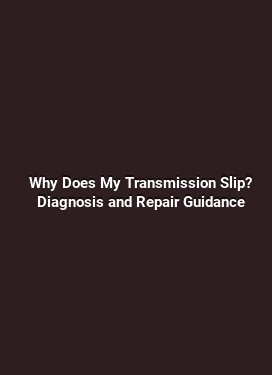Dual-Clutch Transmission (DCT) Tuning: Getting Faster Shifts
Understanding Dual-Clutch Transmission Basics

Dual-clutch transmissions represent a pillar of modern drivetrain design, combining two input shafts and two clutches to pre-select gears and execute lightning-fast shifts. Unlike traditional manual transmissions, where the driver coordinates clutch engagement and gear selection, DCTs leverage sophisticated electronic control to optimize shift points, torque delivery, and pedal feel. This level of control opens up a broad landscape for tuning, where refinements in software logic, hydraulic actuation, and mechanical components can yield tangible gains in responsiveness without compromising reliability.
At its core, a DCT uses one clutch for odd-numbered gears and another for even-numbered gears. This arrangement allows the next gear to be pre-engaged while the current gear remains engaged, enabling shifts with minimal interruption to torque. The electronic control unit (ECU) or transmission control unit (TCU) orchestrates gear selection, clutch modulation, and shift timing by reading sensor data such as engine RPM, vehicle speed, throttle position, torque requests, and vehicle dynamics. The result is a seamless or aggressively precise shift depending on tuning goals and safety constraints embedded in the software and hardware design.
Key Components That Influence Shifts

Several subsystems determine how quickly and smoothly a DCT shifts. Understanding their roles helps frame effective tuning strategies:
- Clutch Preload and Actuation: The hydraulic or electro-hydraulic system applies pressure to the clutches. Tuning this pressure curve can reduce clutch slip and shorten shift duration, but excessive preload increases wear and heat.
- Shift Logic and Timing: The control strategy decides when to engage the next gear based on throttle input, RPM, and torque feedback. Fine-tuning shift points can dramatically affect perceived response, especially in sport or track driving modes.
- Torque Management: The ECU may limit engine torque during shifts to prevent wheel hop or driveline stress. Carefully adjusting this limiter can preserve acceleration feel without compromising safety.
- Mechatronics and Gear Actuation: The mechanical package that physically engages gears must respond rapidly and predictably. Calibrating valve timing, servo response, and wear compensation can yield measurable improvements.
- Lubrication and Cooling: Proper lubrication reduces friction and clutch heat, which is crucial during aggressive shifting. Upgrades or optimization in cooling strategies help sustain performance under strenuous conditions.
Foundations of Safe and Effective Tuning
Before diving into any modification, it is essential to establish safe baselines. A thorough data-informed approach ensures that gains in shift speed do not come at the cost of reliability, drivability, or warranty coverage. A balanced tuning path begins with precise measurement, controlled experiments, and incremental changes that are validated through repeatable tests such as 0-60 mph times, quarter-mile runs, and in-gear response during off-throttle and on-throttle transitions.
Advanced tuning often starts with data logging. Modern DCT systems expose a wealth of telemetry: clutch temperature, actuator current, line pressure, gear engagement latency, slip thresholds, and torque request vs. actual torque. Analyzing these traces helps identify bottlenecks such as slow actuator response or excessive torque reduction during shifts. It also clarifies whether improvements should prioritize software logic, hydraulic actuation, or mechanical wear mitigation.
Baseline Assessment: What to Measure First
A practical baseline includes recording shift times, clutch slip duration, and engine/transmission temperatures under normal driving, then during high-demand scenarios. Compare shifts across different driving modes and with traction control engaged as a control condition. If possible, capture data before and after any change to verify that the modification produces a consistent, repeatable improvement rather than a one-off fluctuation caused by ambient conditions.
Practical Tuning Techniques for Faster Shifts
Below are actionable topics and methods that engineers and enthusiasts commonly explore to achieve quicker shifts. Each technique is described with practical considerations, expected outcomes, and safety notes to help navigate trade-offs between speed, feel, and longevity.
1) Optimizing Shift Points and Curves
Shift point optimization involves aligning the moment of gear change with the optimal engine torque peak for each gear. This often means raising or lowering the RPM threshold for upshifts and downshifts, or adjusting the throttle-blip behavior during downshifts. A more aggressive curve reduces shift latency, especially in high-performance driving, but may increase engine noise and peak torque demand on the driveline. The key is to tailor the curve to the vehicle’s current state, including load, speed, and temperature, so shifts remain linear and predictable rather than abrupt or harsh.
Driver-adaptive strategies—where the system learns from repeated driving patterns—can further refine shift timing. When enabled, the ECU can accumulate knowledge of typical throttle inputs and road grades to anticipate the upcoming shift. This anticipatory behavior translates into smoother transitions and a perceivable drop in shift lag over time.
2) Modulating Clutch Preload and Slip
Clutch preload is the initial pressure applied to the clutch pack. A higher preload reduces the time needed to engage a clutch during a shift but increases frictional heat and wear. Tuning this parameter upward can shave milliseconds off a shift under controlled conditions, particularly in track driving where temperatures are monitored and cooling is optimized. Conversely, reducing preload improves efficiency and longevity but may increase the chance of slight slip or a marginally slower engagement under extreme load. The balancing act requires monitoring clutch temperature and slip behavior across the shift envelope.
Some DCTs include a slip-target strategy, where the system intentionally allows a brief, controlled slip to smooth the transition. When used judiciously, slip-targeting can create a refined, almost seamless shift. However, excessive slip accelerates wear and reduces efficiency, so it must be calibrated with real-time sensor feedback and maintenance considerations in mind.
3) Enhancing Shift Timing with Torque Programming
Torque programming adjusts how much engine torque is delivered or briefly reduced during a gear change. A precise reduction can prevent tire slip and chassis instability while preserving the illusion of instant acceleration. In a tuned DCT, you might see a tighter throttle response window during shifts, with the system trimming torque for the exact moment the next gear engages. For street driving, a moderate torque reduction often yields the most satisfying blend of urgency and controllability; for track use, more aggressive torque management can be beneficial when paired with robust cooling and clutch monitoring.
4) Upgrading Mechatronics Reliability
The mechatronic unit (the electronic heart of the transmission) governs valve actuation, pressure modulation, and gear engagement sequencing. Upgrading firmware in a controlled environment can improve response times, but care must be taken to ensure compatibility with the hydraulic hardware and transmission cooling strategy. Strong performance gains from software alone can be offset by heat buildup or valve sticking if the hardware cannot sustain elevated pressure cycles. Therefore, a holistic approach—software, hardware, and cooling—tends to produce reliable, repeatable improvements.
5) Cooling and Thermal Management
Shifts performed in high-temperature conditions can experience diminished speed due to thermal throttling. Enhancing cooling path efficiency, increasing transmission fluid capacity within recommended limits, or employing higher-capacity coolers can maintain performance during extended sessions. Thermal stability supports consistent shift timing, reduces clutch wear, and preserves line pressure integrity, which directly influences shift latency.
6) Oil Formulation and Fluid Dynamics
The transmission fluid plays a critical role in friction characteristics, heat transfer, and hydraulic response. High-performance fluids may offer lower viscosity at operating temperatures and improved shear stability, contributing to faster hydraulic actuation and crisper shifts. It is essential to select fluids that meet manufacturer specifications, as improper viscosity can impair gear engagement or lead to unforeseen wear patterns. In some tuning projects, a fluid with selective additives can help sustain smoother engagement under aggressive shifting while maintaining protective film strength between clutch plates.
7) Safety Interlocks and Warranty Considerations
Any tuning activity must consider safety interlocks and potential warranty implications. Most modern DCTs include protection logic that guards against overt torque spikes, abnormal clutch temperatures, and mis-synchronization. Tuning strategies should respect these boundaries by verifying that changes remain within the operational envelopes defined by the vehicle maker or by the aftermarket solution provider. Documentation of changes, test procedures, and temperature compensations is key for traceability and long-term reliability.
8) Data Logging and Verification
Post-modification validation relies on data logging across multiple driving scenarios. Check for consistent reductions in shift latency, stable clutch temperatures, and acceptable torque profiles during shifts. Graphical traces that illustrate engine RPM, clutch current, and line pressure can reveal subtle inconsistencies that require further refinement. Establishing a test matrix that includes cold starts, hot laps, and varied throttle inputs helps ensure that improvements persist across conditions.
9) Real-World Driving Scenarios and Feel
Shifts should feel confident and predictable, not dropped or overly abrupt. In everyday driving, you want a quick response without sacrificing comfort. In performance or racing contexts, drivers appreciate the instant bite of a shift, minimal drivetrain interruption, and a feel that communicates the exact moment of gear engagement. The art of tuning lies in delivering the right sensation for the intended use case, with the control system transparently managing stability and durability.
10) Long-Term Durability and Maintenance
Any performance-oriented adjustment affects wear surfaces, particularly clutch packs and gear teeth. Regular inspection intervals, fluid replacement schedules, and monitoring oil degradation indicators become part of the tuning lifecycle. A robust tuning plan includes a maintenance roadmap that aligns with the vehicle’s use profile, ensuring that gains in shift speed do not come at the cost of increased maintenance or unexpected downtime.
Case Studies: Practical Scenarios and Outcomes
Consider a performance-oriented hatchback equipped with a dual-clutch transmission. A baseline evaluation shows average upshift latency of 120 milliseconds in Sport mode, with clutch temperature rising toward the upper limit during track sessions. By implementing a staged tuning plan—adjusting shift curves for upshifts at higher RPM bands, enabling adaptive shift logic, and modestly increasing clutch preload under controlled conditions—the shift latency improves to around 90 milliseconds. Temperature trajectories stabilize, allowing longer track sessions before the first thermal limiter engages. In daily driving, the system maintains smooth response with minimal perceptible change in pedal feel.
In another example, a high-torque front-wheel-drive sedan experiences occasional downshift hesitation during aggressive throttle reduces. A combination of torque programming and a refined downshift blip strategy reduces perceived lag, while maintaining drivability in corner entry. The result is a crisp, confident downshift that preserves vehicle balance without abrupt throttle dips.
Integrating Trend Dynamics and Semantics in Tuning
Modern tuning discussions often reference trend dynamics like shift speed optimization, torque smoothness, and climate-adaptive behavior. Semantically, it helps to relate shifts to torque curves, gear ratio progression, and hydraulic dynamics. A comprehensive tuning narrative uses these concepts to explain how each modification translates into perceivable changes in acceleration authenticity, steering feedback, and gear engagement clarity. Practitioners also consider environmental and usage trends, such as city traffic patterns, spirited canyon runs, and endurance sessions, to tailor the tuning approach to the vehicle’s real-world role.
Closing Thoughts on DCT Tuning Philosophy
Effective DCT tuning blends precise software calibration, robust hydraulic behavior, and reliable mechanical wear management. The objective is to deliver faster, more consistent shifts that enhance the driving experience while preserving drivetrain health and confidence. This approach emphasizes data-driven decisions, incremental testing, and a clear understanding of the interplay between shift timing, clutch dynamics, and torque management. By focusing on measurable outcomes, tuners can achieve tangible improvements that harmonize with the vehicle’s character and the driver’s intent.






